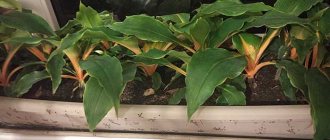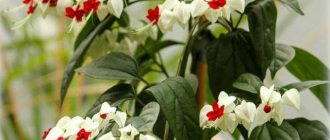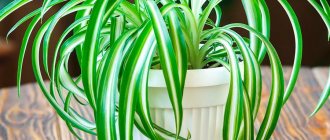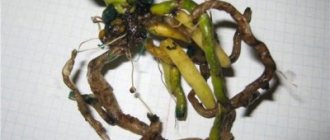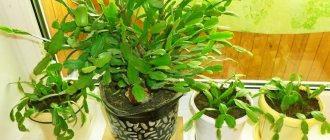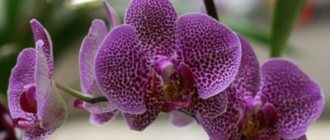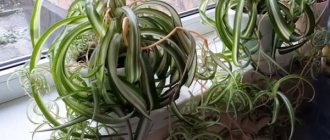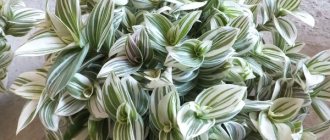History of the Latin name of the plant
Chlorophytum adapts perfectly to almost any environment. It has several features that allowed it to quickly spread throughout tropical America:
- unpretentiousness;
- fast growth;
- the ability to be in the ground and in the water.
Reference .
Scientists still do not agree on which family this culture belongs to. Some classify it as a lily for its ability to grow in water, but others find many similarities with aspholedaceae. The name itself can be translated as “green plant”. However, chlorophytum also has several unofficial definitions - spider and green lily. This family numbers more than 200 species. Each of them has its own characteristics. However, due to their common characteristics, they are classified as one family.
Reproduction
Reproduction occurs by rooting daughter rosettes or by dividing the rhizome with part of the rosette of leaves during transplantation. Thickened parts of roots and other sections should be sprinkled with crushed charcoal or sulfur in order to avoid rotting. You can plant daughter rosettes immediately in prepared pots or soil, the same as for adult chlorophytums. It is not necessary to cover and spray the shoots.
Origin and homeland of the green flower
South and Central America are considered the homeland of this plant. It can also be seen in the northern part of the American continent, but it prefers chlorophytum to the tropics. Unlike a number of other crops, it can grow simultaneously in water and dry soil, which significantly expands its distribution area.
Scientists managed to domesticate this flower quite quickly, as a result of which it spread to all continents except Antarctica. In its natural environment it can be seen in the following areas:
- Central and South America;
- South-East Asia;
- Indonesia.
This became possible only thanks to the domestication of the flower and its further cultivation in a new territory for it. It took root quite quickly and is now growing well in the proposed conditions.
What does simple chlorophytum look like?
It is necessary to understand exactly what simple chlorophytum looks like. It is believed that all other varieties and varieties came from it. Let's take a closer look at the appearance of this plant.
Appearance
This is a herbaceous evergreen plant, which has a large number of subspecies. Given their diversity, it is not always possible to identify a culture.
Here are the main features:
- the stem is shortened. A large number of leaves grow from it;
- The bush itself is small. Usually does not exceed 60 cm in diameter with about the same in height;
- leaves are evergreen, elongated, reduced type;
- there may be small white flowers in the form of stars;
- after the end of flowering, numerous daughter plants are formed, each of them has its own root system.
Reference . Today there is one- and two-tier chlorophytum. Very rarely in nature you can find a third tier. However, for a small stem it is very difficult to hold. There are bushy and tree-like varieties. The latter have a thick stem, which can have up to five tiers at a time.
Blooming chlorophytum with photo
This plant can bloom quite profusely. But this requires achieving ideal conditions. If they do not meet the requirements, then the bush remains evergreen.
For flowering you need to provide the following:
- timely watering;
- correct transplantation;
- feeding;
- temperature regime;
- air humidity.
Under favorable conditions, several flowers appear on the plant. After this, new plants are obtained from them. Thus, Chlorophytum reproduces through flowering. If conditions are not optimal, then it will grow without producing offspring. But this does not mean that you cannot get another plant. More details about reproduction methods will be written below.
Description of the structure
To briefly describe this culture, we can identify the following:
- leaves are collected in a rosette;
- stem shortened;
- type of leaf attachment - sessile;
- the shape of the plate is linear, the upper part is pointed or elongated;
- The leaf is simple, without branches, with parallel veins, entire.
Important! This description is only suitable for Chlorophytum vulgaris. Other varieties may differ significantly from it in appearance.
Root system
This plant grows quite quickly thanks to its developed root system. It differs as follows:
- yellowish color;
- branched roots;
- They quickly take up the entire pot.
The roots absorb nutrients in the soil well. Since they grow quickly, it is necessary to replant the plant in a timely manner. Otherwise, the pot may burst. It is also recommended to fertilize regularly. This will speed up growth and make flowering more abundant.
Planting chlorophytum
It is necessary to plant chlorophytum correctly so that it feels normal and grows quickly. Experienced florists say that the correct technique determines how quickly the flower adapts to new conditions and continues to grow. Therefore, do not underestimate the importance of correctly planting and replanting chlorophytum. It’s worth taking a closer look at exactly how to do everything and in what order.
Preparation
Before planting chlorophytum, you need to perform several steps. In particular, it is required:
- buy a suitable pot, which will be made of plastic or clay;
- purchase special soil or make it yourself;
- take planting material.
Reference . There are special requirements for the soil. It must have neutral acidity. Suitable universal soil for indoor flowers. Many florists prefer soil intended for deciduous plants. Culture feels good in it. However, it is additionally required to add humus and sand. The finished soil should allow water to pass through perfectly. Therefore, it is recommended to periodically weed after watering.
How to plant a flower at home?
The planting process is standard. It requires following a certain algorithm, namely:
- a drainage layer is formed in the pot;
- then the substrate is poured;
- the baby is separated from the main bush;
- planted in a pot;
- the root system is sprinkled with earth;
- watering is carried out.
Important! The plant loves abundant watering, but it is forbidden to overwater it. The top layer of soil should always be moist. Therefore, you need to moisturize it in a timely manner. You can also lay moss on top to protect the soil from drying out quickly.
Pests
Chlorophytum can be affected by various pests, including scale insects and spider mites.
Scale insects have the form of plaques or bulges. Reach 2-3 mm in diameter. They have a reddish and sometimes translucent brownish color. The pest is located on the surface of the leaves, along the main vein on the upper side. The scale insect feeds on plant sap, which causes the leaves to fall off. To get rid of the pest, the flower is wiped with a soapy sponge or alcohol solution, after which it is watered with a systemic insecticide.
Since the homeland of chlorophytum is a subtropical climate, the plant loves moisture. Excessively dry air causes spider mites to appear. It is a small arachnid pest, no more than 1 mm in size. It is almost impossible to see it with the naked eye. The first place to look for mites is on the back of the leaves, where you can see traces of the pest's molting, similar to small crumbs or dandruff. To combat mites, wipe the plant with soapy water or rinse in the shower. In case of severe damage, chlorophytum is sprayed with an insecticide. For prevention purposes, the plant should be regularly moistened with plain water.
How to grow chlorophytum at home?
You need to know how to properly grow a plant so that it feels great and blooms profusely. There are several recommendations from experienced florists. By following them, you can ensure rapid growth.
Temperature
This flower is considered unpretentious. It adapts perfectly to almost any conditions.
Here are some recommendations:
- the upper limit of the temperature regime is 27 degrees;
- lower limit - 18 degrees;
- changes of more than 5 degrees are undesirable.
Reference . The flower doesn't really like it when the wind blows around the room. There is a risk that the leaves will turn yellow and gradually wither.
Lighting
It is very important that the plant is comfortable. To do this, you need to provide proper lighting. The flower loves light, but is afraid of direct sunlight. Burns appear almost immediately. Therefore, diffused light is recommended.
Recommendations for choosing a location:
- it is better to place it in the kitchen, since chlorophytum loves a large amount of carbon dioxide;
- It is recommended to install not on a windowsill, but in a place with sufficient light;
- if there is not enough sun, the leaves begin to fade and growth slows down.
All this is important to consider when choosing a place for a flower.
Watering
It is very important to water this crop correctly. Here are some rules:
- The plant is moisture-loving, so it is better to overwater than underwater.
- The top layer of soil should be kept moist at all times.
- Frequent overwatering is harmful to the culture. In this case, the roots begin to rot.
- If for some reason the soil is dry, place the plant in a sink with water for about an hour so that moisture is constantly in the pan.
- When watering, it is necessary to supply water through the pan and from above.
- Periodic spraying of the crop with a spray bottle is highly recommended.
Reference . To make the plant feel better, use rain or settled water.
If watering is very abundant for a long time, the roots begin to rot. In this case, you need to urgently replant the flower. In this case, it is necessary to remove the rot and use a new substrate. Before transplanting, but after the flower is pulled out of the ground, the roots are dried for 3-5 hours. After this, the crop can be planted in a new pot.
Air humidity
Considering how much the culture loves water, it is logical to assume that it needs high air humidity. This is true. The optimal indicator is 80-90% . If the parameter becomes about 65%, then chlorophytum begins to slowly dry out. It needs more abundant watering.
To eliminate growth problems, experienced gardeners install a humidifier in the room with plants. However, not everyone can afford it for various reasons. There is a cheaper solution to the problem. It is enough to place a container of water next to the pot.
Top dressing
It is important to periodically feed this plant. If there are enough nutrients, it will grow faster. However, we must remember that excessive feeding kills the crop.
Here are the basic rules for feeding:
- Fertilizers should be applied from spring to autumn.
- It is necessary to use complex or universal compositions for indoor flowers. They should contain potassium, magnesium, phosphorus and superphosphate.
- You can make fertilizers yourself. For example, from banana peels, which are infused in one liter of water.
- The frequency of feeding is 2 times a month.
Reference . If a flower reacts poorly to feeding, then fertilizer is not suitable for it. You shouldn't continue to use it. It's better to try something else. You can find out which one is suitable only experimentally, taking into account the number of subspecies of chlorophytum. However, as practice shows, problems do not arise when using universal fertilizers.
When performing proper watering, not everyone remembers the need to apply fertilizer. In this case, it is impossible to achieve rapid growth and abundant flowering. Over time, the soil becomes depleted. Then the flower feels bad. It may die if a pot is purchased “for growth.” However, if you choose the right container, there are no problems. The soil changes every year. If it's from a store, it's fortified with nutrients. They are just enough for about 12 months.
Transplantation and how to plant?
It is necessary to replant the plant every year. The fact is that the root system grows quite quickly and becomes crowded. However, the new pot should not be too spacious. It is recommended that it be 2-3 cm larger than the previous one.
Plant transplantation process:
- In spring a new pot is prepared. If you have children and plan to plant them out, you will need several pots.
- Then separate the rosettes from the main chlorophytum using a sharp knife.
- First, the children are planted according to the boarding algorithm.
- Then you need to pull out the main plant and clean its roots from the substrate.
- Afterwards you need to inspect whether there is rot on the roots. If present, it is removed.
- Next, you need to plant the flower in a new pot and sprinkle it with soil.
Important . It is highly recommended to use store-bought soil. It is already enriched with nutrients and is completely suitable for chlorophytum. It is also disinfected, so there is no risk of pests.
If a flower is sick, you need to act quickly. He does not have a very strong immune system, which does not allow him to experiment. It is best to use fungicides. Industrial pesticides are used against pests.
When does flowering begin?
Flowering can only be achieved under the following factors:
- optimal conditions of detention;
- timely pruning;
- periodic feeding.
Flowering usually occurs from spring to autumn . In winter, the plant is dormant. Thus, you can see flowers only in the warm season, but for this you need to ensure that the culture is happy indoors. The flowering itself lasts about one month.
Root care
The root system does not require special care. However, several important factors must be taken into account, namely:
- replanting a flower every year;
- if there is rot, it is necessary to cut off damaged roots;
- if the bush is divided, then the cut site must be treated with antiseptics;
- When replanting, you need to be careful and carefully clean the root system from the substrate.
These are the main nuances that you need to remember when taking care of the root system. It is not recommended to add organic fertilizers. They will burn the roots and the flower will die. If there is a strong desire to use them, then the dosage should be small, and fertilizing should be done exclusively in liquid form.
What difficulties are possible when growing at home?
If you are planning to grow a spider at home or it is already showing off in your apartment, you should be aware of the unpleasant surprises that you may encounter.
Arrange “Sahara” in an apartment with excessively warm air and lack of moisture - the plant will respond with a strike - the tips of the leaves will turn black .
- If there are heating devices near your green pet, spray it occasionally.
- Plant a perennial in a pot that is too small and the flower stalks will stop growing.
- If the flower is illuminated by the bright sun for a long time , it will begin to dry out.
- Overdo it with winter watering in addition to poor heating of the room - dark spots will form on the leaves.
- If you place it in a dark place, it will lose its bright color, the leaves will constantly reach towards the light and become excessively elongated.
- If a flower briefly falls under scorching rays or in a semi-dark place, nothing bad will happen to it. But: in the first case, the time should be no more than a few hours, in the second - several days.
Chlorophytum combines a rare combination of characteristics of an indoor flower - delightful beauty and unpretentiousness. It will get along in any pot, does not need fertilizer and will tolerate even irregular watering. Provide it with modest care, and it will delight you with its rich beauty.
How to use chlorophytum in the interior of an apartment?
This culture is often used to make an apartment more attractive. The flower also has many positive properties. It is worth considering all these nuances in more detail.
Benefits for the home
Chlorophytum is often grown by florists at home. Moreover, you can often find several species at once in one apartment. Diversity allows you to create original interiors. When the babies hang from the main bush, it looks very beautiful. The same applies to crested chlorophytums. Orange ones are much less common.
Regardless of the type of flower, it has many useful properties, these include the following:
- Purifying the air from harmful impurities and toxins.
- The plant is quite beautiful and decorates the interior.
- Indoor air humidification.
- Prevention of colds.
- Reducing the risk of developing allergies. If it exists, then its negative impact is suppressed.
This flower is often bred not only for its decorative qualities, but also for its beneficial properties. However, it is worth setting it higher if there are small children in the apartment. The fact is that its juice is poisonous to humans: if a baby bites a leaf, it can be poisoned.
Today chlorophytum can be seen in many institutions and apartments. The plant is unpretentious. The number of species is amazing, and new ones appear periodically. But this is already the result of the work of breeders. It is not difficult to propagate this crop, since after flowering a new flower always appears. Thus, this is an excellent opportunity for novice florists to practice growing indoor flowers.

